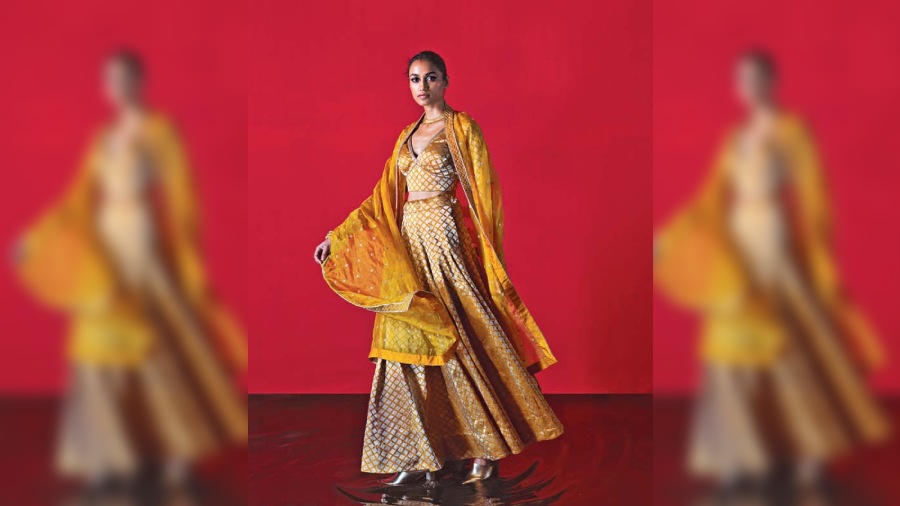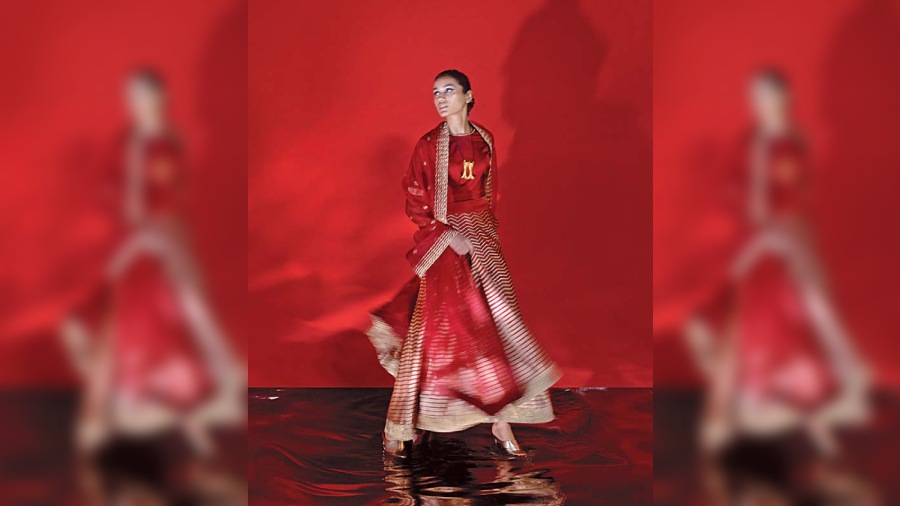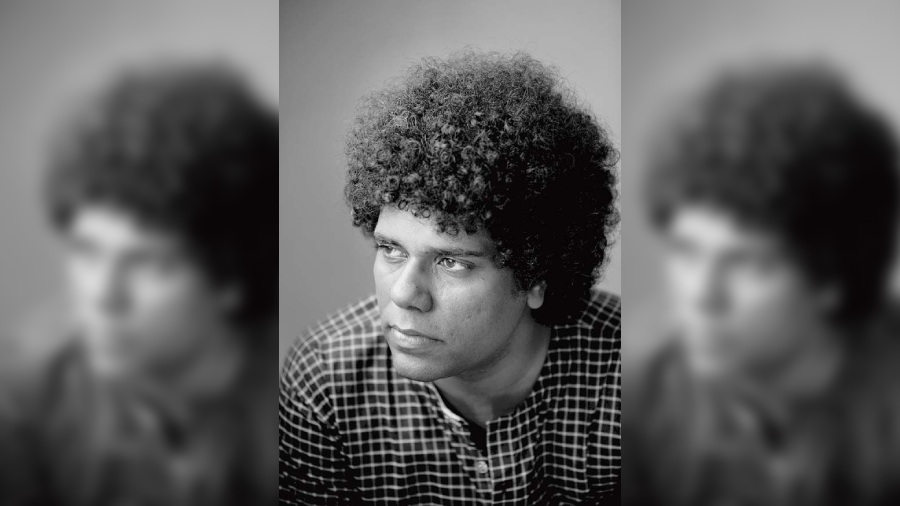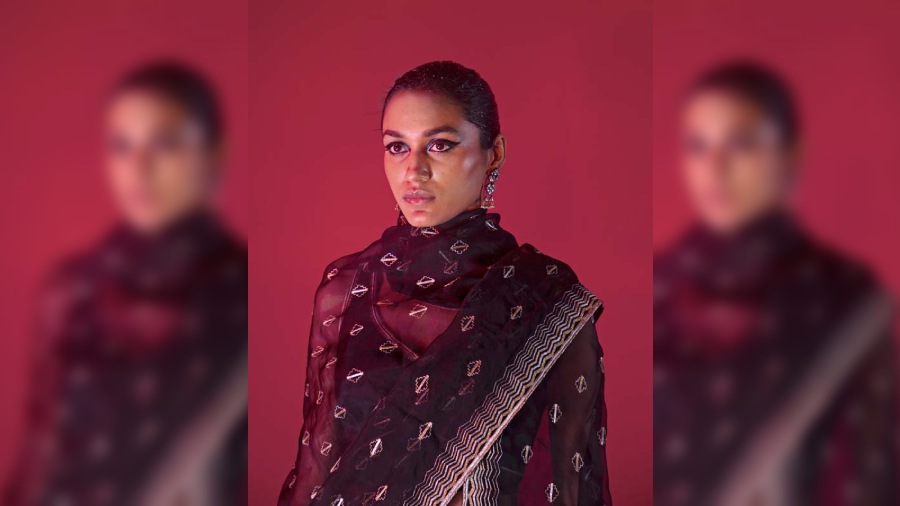Gaurav Jai Gupta was travelling to Kolkata, his first work trip since the pandemic broke out in 2020, to showcase at the The Wedding Edit, in association with The Telegraph, at The Loft in Quest recently and had definitely had ‘fish’ on his mind. From the platter to the palette. Gaurav showcased ‘Meen’ (meaning fish) and ‘Shoja’, both “conversation starters”. On his way to The Astor, Gaurav told us how he is currently approaching work and who he designs for.
When did you resume travelling?
I think just a month-and-a-half. This is my first flight since Covid. Funnily, the last flight was also Kolkata before Covid.
How did you feel when you got onto that flight?
I am travelling with my wife and for both of us, it is the first work trip. Akaaro started from Kolkata because I started weaving in Phulia. So, I have a lot of memories from when I initially started coming in. From the airport till the hotel, it has been nostalgic. The skyline has changed around Science City, that particular pocket. The flight was usual, but I am definitely less hassled. Earlier before a show, you are hassled, ticking off the checklist. This time I am not feeling stressed out and we have come a day before. It’s an easy trip. I want to see and observe. It’s almost as if you have come after a lifetime.... it’s almost as if I have forgotten to do exhibits. Even while doing the checklist, we had forgotten a few things....

So, what is your approach to work now, vis-a-vis pre-Covid?
I think it is more organised from what it was earlier. We got a break when we saw things from the outside, when you are in it, it’s different and when you are out, it’s different. When we restructured the team, it’s a new energy, it’s fresh and then it also has a lot of challenges. We have moved our studio and we are opening a new space in Delhi, a concept space. Covid has given a lot of food for thought in terms of structuring things down and consolidating and editing in terms of the overall business. It’s leaner and focused and definitely interesting and challenging for sure.
Akaaro turned 10 in 2020. Were you anyway thinking of reviewing how the brand was working?
There are no deliberate ideas that we want to revisit or reinvent because it is timeless and the visual aesthetic is also new, but at the same time, I definitely have a signature. We want to explore more and expand our skill base. Earlier I was doing woven and now I am getting into prints. We have played with a little bit of embroidery. I have done this bridal line called Meen, which I have brought to Kolkata. Authentic, contemporary bridal lehngas. We want to build on what the brand’s legacy is, develop more and then take that forward.

Tell us more about ‘Meen’ and ‘Shoja’...
This is the first time I am getting these collections outside Delhi, in a show like this. They were both developed during Covid and did not have that kind of an exposure from a retail perspective. It’s mostly been digital or at stores where we retail from and we have not been retailing from anywhere in Kolkata for a while now... for the last two years.
'Meen' does not have your typical routine lehngas. They are modern and contemporary with no motifs and geometric, minimal, structured, sharp, modern and easy. Whosoever wears it can move around freely. The colours are fresh and you can always wear it post the wedding. From a styling point of view, we are giving the new bride a lot more options and the most important thing is they are authentic. We have kept it tight as to what is required. They are woven with 5g real zari. So, they are like gold-plated. Most of them are like that. It’s taken a while to build this up. Obviously I have never done bridal. The embroidery is in the dupatta, signature Akaaro. It was my struggle to come up with embroideries that are relevant to Akaaro.

'Shoja' is again occasionwear, woven pieces with no embroidery. Metallics and bright colours, modern colours. Mostly, dresses, tunics, shirt dresses and coord sets. There are a lot of saris.
Meen is Sanskrit for ‘fish’ and it looks at the underwater glaze because my work has a lot of glaze, metallics, sheen.... I have been working on this as an idea for a while... why do we celebrate and how do the festivals come? We were looking at mythology and then... we looked at a lot of underwater reflections. When the light falls on water what happens? We looked at fish scales.
Shoja is a place (in Himachal Pradesh). The vibe was... moody.

Shoja
Do you see many more takers for your aesthetics post-pandemic?
Hundred per cent. It’s got a lot to do with educating the consumer. You are right... it is a smaller space compared to the traditional market, but it picks up slowly and then catches on with my work. People who come to me know exactly what they are getting. And there are a lot of people who want this. When I got married, I wanted something authentic. What resonates with us in terms of a family, the rituals we have. I am a Gupta, a baniya Marwari and because I understand the history of a product, I had the clarity of not getting into a certain aesthetic. We wanted to be more authentic and pure and I didn’t want too much drama.
I think this is for real people, who understand quality. That is what luxury is. As a label, we are for independent people. We are for strong women, with a clear mind.

Your menswear is different...
We started out a western line. Also, when I got married, I didn’t really find anything to wear. I want to wear clothes which are elegant and understated. I am a sucker for things which are pure. We have done natural kurtas in pista, beige, pink, ivory... metallic waistcoats....
Picture courtesy: Designer
